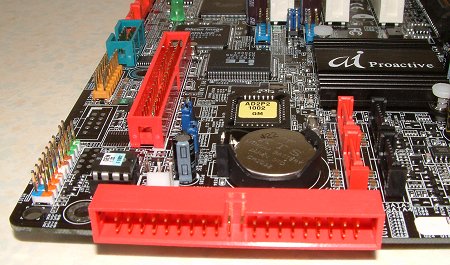P5AD2 layout and features

As we have seen on the previous page, the P5GD2's bigger brother, the P5AD2 925X, shares an extremely similar feature set. ASUS, however, has redesigned the board's layout. It's not clear to see why, as both 900-series boards carry triple RAID, dual Gigabit Ethernet, FireWire800, and a solitary ICH6/R-powered PATA port.
What wasn't shown in the P5GD2's layout was ASUS' Stack Cool technology. Stack Cool comprises of a mini-PCB that conducts heat away from the hottest part of the board. It's no gimmick, as removing the board immediately after prolonged usage showed just how hot the Stack Cool plate became. It's thin enough so as not to compromise the board's fitting into any regular case.

Both boards also share a large-ish passive heatsink that does a decent job of cooling the components that push out the most heat. We appreciate how ASUS has gone to lengths to ensure cooling takes place without undue noise. The 925X model's revised layout begins with the single PATA port being located to the right of the 24-pin power connector. Truth be told, it makes little or no difference.

Comparing the P5AD2 Premium directly to the P5GD2, we see the 4 ICH6/R SATA ports have been rotated anti-clockwise and ITE's PATA RAID controller's port is now rotated to the side, in true ASUS fashion. Again, there's little wrong with how it sits on the P5GD2. Strangely, ASUS has done away with the third PCI Express X1 slot and re-introduced a third PCI (32-bit, 33MHz) slot instead. TI's 1394b controller is now pushed to the left.

The quality of on-board audio, excepting NVIDIA's excellent nForce2 APU and select integrations of VIA's Envy-based audio, has been historically weak. Intel's seen fit to replace mediocre AC'97 with new, high-definition audio, stemming from the ICH6 southbridge. ASUS has chosen to pair the new 24-bit precision and 192KHz sample audio with CMI's 9880 (Azalia) 8-channel CODEC. Basic listening showed the package to be a capable performer for MP3-based playback.

We're looking at a carbon copy of the P5GD2's I/O section. That's not a surprise; both motherboards carry similar feature sets. Just a note. The single FireWire port is 1394a (400Mbps). Both 1394b ports are run via the supplied bracket.
It's not altogether clear why ASUS has two different layouts for motherboards with near-identical features. Both, however, work well. Installation was easy in both cases. Given a choice, we'd probably take the P5GD2's 3 PCI Express X1 (500MB/s) slots and sacrifice a third PCI (133MB/s) slot. Both boards have enough incorporated features to almost do away with additional expansion slots.









